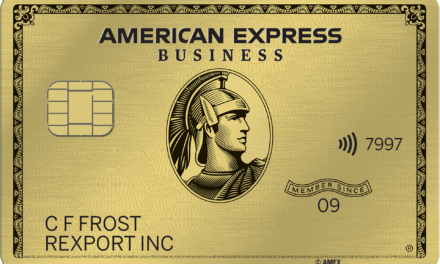The American Express Business Gold Card and the Chase Ink Business Preferred are two of the best mid-tier business credit cards in the industry. The Amex Business Gold Card is one of the original charge cards devoted to business. And it was revamped in the fall of 2018 to much acclaim. Conversely, the Chase Ink Business Preferred is one of the best newer competitors in the industry.
Both cards are in Tier III, despite a $200 difference in annual fees. The Amex Business Gold Card has a whopping $295 annual fee. Meanwhile, the Chase Ink Preferred has a more standard $95 annual fee. Neither card’s fee is waived the first year.
As with everything in point and miles, your mileage may vary. Someone might find the Gold better for him while their best friend mind like the Ink Business Preferred better.
Sign-Up Bonus
The bonus offered with Ink Business Preferred is Chase’s largest. You will receive 80,000 Ultimate Rewards (UR) points after spending $5,000 in the first three months. The Ink Business Preferred used to be the only card with a sign-up bonus. But Amex added a bonus to the Gold Card in March 2019.
The bonus that was added is worth a relatively small 35,000 Membership Rewards (MR) points. It can be earned after spending $5,000 within the first three months. American Express should offer a larger sign-up bonus for that high of a minimum spend threshold. The negative sentiments towards this bonus only grow when you compare it to the Ink Business Preferred Card’s bonus.
80,000 UR points is more valuable than 35,000 MR points regardless of minimum spend. But the fact that both cards have same minimum spend is jarring. Therefore, the Ink Business Preferred is the winner of this category.
Earning
American Express Business Gold Card
The Business Gold Card earns 4x Membership Rewards (MR) points on two categories of choice. It also earns 2x points on the remaining categories and one point per dollar on all other purchases.
The categories to choose from are:
- Advertising (TV, radio, and online only)
- Select Computing Merchants
- US Gas Stations
- Shipping
- Airfare (booked directly with the airline)
- US Restaurants
The beauty of Amex’s categories is that cardholders can pick two of them based on their business’ expenses. Plus, cardholders can change the categories every January for upcoming expenses. Such flexibility and the 4x multiplier make the Business Gold Card very powerful.
Chase Ink Business Preferred
Conversely, the Ink Business Preferred earns 3x UR points on the following categories:
- General Travel (same broadness as the Chase Sapphire Cards)
- Social Media and Search Engine Advertising Purchases
- Shipping
- Internet Services
- Cable & TV Services
- Phone Services
Chase has six categories that cannot be chosen for a higher multiplier. All of them earn the same amount of points per dollar, making the Ink Business Preferred great for businesses who want more simplicity.
Analysis
Both mid-tier business credit cards have a $150,000 per year limit across all bonus categories. In other words, it is possible to earn six figures in each points currency per year if you spend within the categories
The Business Gold Card is better for businesses with high gas, dining, and computing expenses because the Ink Business Preferred does not offer these categories. However, cardholders can other pick these categories to earn 4x MR points for businesses with huge expenses within them. Conversely, the Ink Business Preferred is better for internet, cable & TV, phone, and general travel expenses. Both cards share a category in shipping.
Therefore, the winner depends on cardholders’ business expenses and what type of points they want to earn.
Burning
Hotel dwellers will be better off with Chase’s partners. And international travelers will be better off with Amex’s partners. Both cards offer great partners for domestic travelers.
Perks
The Business Gold Card’s most notable perks include QuickBooks access, Trip Delay Insurance, and the Amex Hotel Collection. This is one of the reasons why the Gold Card’s annual fee is more than three times that of the Ink Preferred.
The Ink Business Preferred comes with cell phone protection, primary car rental insurance, and other insurances. This card’s perks are closest to those of the Chase Sapphire Preferred.
Both cards have similar perks. However, the Ink Business Preferred has more travel insurances than the Business Gold Card. That includes having primary car rental insurance (as opposed to the Business Gold Card’s secondary coverage). It also has more perks that can be useful and the victory in this category.
Credit Limit
The Ink Business Preferred is a traditional revolving credit card. It comes with a set limit and can be hard to get approved for those with lower credit scores. This card lets you keep a balance, even though that is not recommended.
The Business Gold Card is a charge card which does not have a preset limit. In other words, Amex charge cards have internal limits that can change every month. The Business Gold Card is the better card for those with lower credit scores because it’s a charge card. It also forces cardholders to pay in full.
Final Draw
The mid-tier travel business credit cards from Chase and American Express are great options for business owners and employees who travel often. Both cards have strengths and weaknesses.
The Chase Ink Business Preferred is the better card for most businesses. It has a modest annual fee, an excellent sign-up bonus, practical categories, and a great earning structure. Its only weakness is its minimum spend for the sign-up bonus. Conversely, the Amex Business Gold Card has an excellent earning structure and some nice perks. But it lacks a substantive sign-up bonus and it has a very high annual fee.
Some businesses can justify the Business Gold Card’s $295 annual fee with enough bonus category spend. But most businesses would be better off with the Chase Ink Business Preferred. It has similar earning opportunities and more perks for about 1/3 of the annual fee.
Apply Today:




